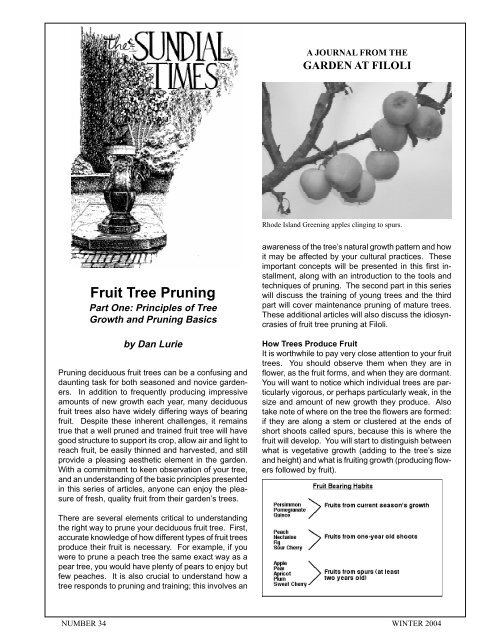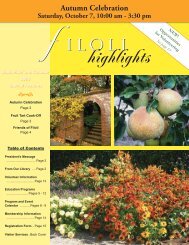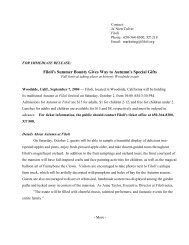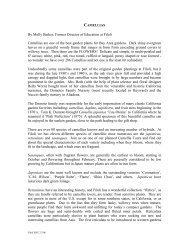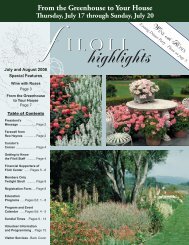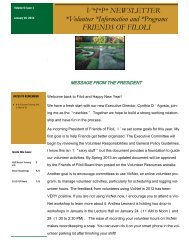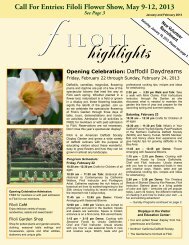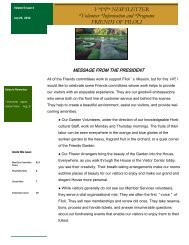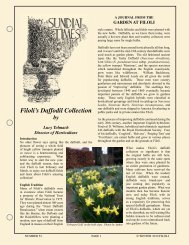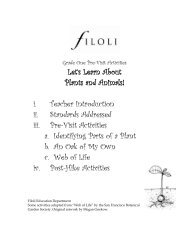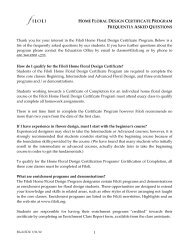You also want an ePaper? Increase the reach of your titles
YUMPU automatically turns print PDFs into web optimized ePapers that Google loves.
<strong>Fruit</strong> <strong>Tree</strong> <strong>Pruning</strong><br />
Part One: Principles of <strong>Tree</strong><br />
Growth and <strong>Pruning</strong> Basics<br />
by Dan Lurie<br />
<strong>Pruning</strong> deciduous fruit trees can be a confusing and<br />
daunting task for both seasoned and novice gardeners.<br />
In addition to frequently producing impressive<br />
amounts of new growth each year, many deciduous<br />
fruit trees also have widely differing ways of bearing<br />
fruit. Despite these inherent challenges, it remains<br />
true that a well pruned and trained fruit tree will have<br />
good structure to support its crop, allow air and light to<br />
reach fruit, be easily thinned and harvested, and still<br />
provide a pleasing aesthetic element in the garden.<br />
With a commitment to keen observation of your tree,<br />
and an understanding of the basic principles presented<br />
in this series of articles, anyone can enjoy the pleasure<br />
of fresh, quality fruit from their garden’s trees.<br />
There are several elements critical to understanding<br />
the right way to prune your deciduous fruit tree. First,<br />
accurate knowledge of how different types of fruit trees<br />
produce their fruit is necessary. For example, if you<br />
were to prune a peach tree the same exact way as a<br />
pear tree, you would have plenty of pears to enjoy but<br />
few peaches. It is also crucial to understand how a<br />
tree responds to pruning and training; this involves an<br />
A JOURNAL FROM THE<br />
GARDEN AT FILOLI<br />
Rhode Island Greening apples clinging to spurs.<br />
awareness of the tree’s natural growth pattern and how<br />
it may be affected by your cultural practices. These<br />
important concepts will be presented in this first installment,<br />
along with an introduction to the tools and<br />
techniques of pruning. The second part in this series<br />
will discuss the training of young trees and the third<br />
part will cover maintenance pruning of mature trees.<br />
These additional articles will also discuss the idiosyncrasies<br />
of fruit tree pruning at <strong>Filoli</strong>.<br />
How <strong>Tree</strong>s Produce <strong>Fruit</strong><br />
It is worthwhile to pay very close attention to your fruit<br />
trees. You should observe them when they are in<br />
flower, as the fruit forms, and when they are dormant.<br />
You will want to notice which individual trees are particularly<br />
vigorous, or perhaps particularly weak, in the<br />
size and amount of new growth they produce. Also<br />
take note of where on the tree the flowers are formed:<br />
if they are along a stem or clustered at the ends of<br />
short shoots called spurs, because this is where the<br />
fruit will develop. You will start to distinguish between<br />
what is vegetative growth (adding to the tree’s size<br />
and height) and what is fruiting growth (producing flowers<br />
followed by fruit).<br />
NUMBER 34 WINTER 2004
<strong>Fruit</strong> tree buds: (from left) apple vegetative bud, apple floral/fruit bud on a spur, and peach triple-bud with vegetative bud (center)<br />
and floral/fruit buds. All photos by Alex Fernandez, except where noted.<br />
Different types of growth on a fruit tree result from different<br />
types of buds. When the tree is dormant, you<br />
should be able to distinguish between vegetative buds<br />
and floral buds. On an apple tree, there is a marked<br />
difference between the smaller, flatter buds that exist<br />
along the sides of a long new stem (pruning back to<br />
these vegetative buds will result in more growth) and<br />
the bigger, rounder buds that are at the ends of stems<br />
and spurs (these will produce flowers and then fruit).<br />
On a peach or a nectarine tree, you will notice sets of<br />
three buds along one year shoots. The center bud will<br />
produce vegetative growth, while the two side buds<br />
will open to flowers, followed by fruit.<br />
Deciduous fruit trees produce fruit in one of three distinct<br />
ways. Some trees, like persimmon, pomegranate,<br />
and quince, produce fruit on new growth produced<br />
since spring of the current year. In other cases, like<br />
peach, nectarine, fig, and sour cherry, the trees bear<br />
fruit from shoots grown during the previous year. There<br />
are also trees, like apple, pear, apricot, plum, and sweet<br />
cherry, that produce fruit on spurs, which are short<br />
shoots that are at least two years old and can remain<br />
on the tree, actively producing fruit for years. The essential<br />
difference between these fruiting habits is the<br />
age of the stem that produces flowers and then fruit.<br />
<strong>Tree</strong>s that fruit on the current season’s stems often<br />
have fruit late in the year. The new fruiting wood must<br />
have a chance to grow before it sets flowers. It is very<br />
important to have good structure (well-selected main<br />
branches) to support the weight of the fruit crop on a<br />
tree that fruits on current season’s growth. Other reasons<br />
to prune this type of tree include opening the<br />
canopy for light penetration; removing dead wood, unproductive<br />
suckers and water sprouts; reducing the<br />
height to facilitate fruit picking; and encouraging new<br />
wood production.<br />
<strong>Tree</strong>s that produce fruit on one-year old shoots often<br />
have sets of three buds. The side buds will flower and<br />
then produce fruit, while the center bud may grow into<br />
a new shoot having sets of three buds along its sides.<br />
In addition to pruning for better light penetration and<br />
removing dead wood, unproductive suckers, and water<br />
sprouts, shoot-bearing trees should also be pruned<br />
to remove last year’s fruiting wood which will encourage<br />
a continuing supply of new fruiting shoots.<br />
<strong>Tree</strong>s that produce fruit on spurs often take a few years<br />
to establish spur growth. These short shoots typically<br />
occur at the base of one-year old wood. Once a spur<br />
forms, it will produce fruit every year; whereas a shootfruiting<br />
tree must produce new vegetative growth to<br />
sustain a fruit crop the following year. Spur-fruiting<br />
trees should be pruned to encourage formation of new<br />
spur growth and allow for air and light to reach the<br />
interior fruit.<br />
Plum branch (left) with fruiting spurs and apple spurs (right).<br />
The Effects of <strong>Pruning</strong><br />
One of the most beautiful parts of almost any garden<br />
is the presence of a well trained tree, as this represents<br />
one of the truest intersections between the desires<br />
of the gardener and the force of nature. To work<br />
with a tree’s inherent growth and fruiting pattern is always<br />
easier then to fight against it. <strong>Tree</strong>s want to grow<br />
and fruit; understanding a few basic principles of how<br />
that growth can be affected by pruning will help the<br />
gardener endlessly.
A deciduous fruit tree will put on annual growth that<br />
begins in the spring and goes dormant in the fall. As<br />
part of its lifelong fight against gravity, a tree will put<br />
most of its annual, vegetative growth in an upward<br />
direction, towards the sunlight that provides the energy<br />
it needs. Part of the process of the tree growing<br />
upwards is a quality called apical dominance. What<br />
this term refers to is the presence of certain hormones<br />
(auxins) that are produced at the tip of a branch and<br />
travel downwards, inhibiting side buds from growing<br />
into branches. In this way, apical dominance allows<br />
the energy of a branch to be focused at the tip, with<br />
the result being one long branch with no side branches,<br />
particularly near the top, where the auxins are strongest.<br />
As a branch grows, the apical dominance decreases<br />
and the branch will produce its first flowers and fruit.<br />
The weight of the fruit often causes the branch to bend<br />
over from the vertical; this bending interrupts the apical<br />
dominance the tip of the branch was enjoying, and<br />
causes many of the side buds to break. In subsequent<br />
years this branch would have a lot more fruit<br />
than neighboring branches that have remained vertical.<br />
Armed with this knowledge, the gardener can bend<br />
branches “ahead of schedule” and enjoy an increased<br />
crop of fruit—this is the exact rationale behind the<br />
method of training known as espalier (see Sundial<br />
Times Issue # 31). A horizontal branch will often have<br />
an excessive crop of fruit, and put on poor annual<br />
growth. Bending branches to 45 degrees from the<br />
vertical is recommended for balanced growth and fruit<br />
production.<br />
Bending branches is one way to interrupt the apical<br />
dominance the tip of a branch is exhibiting over the<br />
side buds. Another method is through pruning. If the<br />
tip of a branch is removed, the hormone production is<br />
interrupted, and the bud immediately below the cut,<br />
as well as often the next several buds, will break and<br />
grow. By cutting to buds facing in certain directions,<br />
and at certain heights, the pruner can decide where<br />
and in what direction new growth will head.<br />
<strong>Pruning</strong> Cuts<br />
There are two types of basic pruning cuts that a pruner<br />
uses to achieve his or her specific goals. A heading<br />
cut refers to the removal of a portion of a stem. Heading<br />
cuts are made by pinching back a tip or pruning a<br />
shoot or branch back to a bud, but not to another dominant<br />
branch. A plant responds to a heading cut with a<br />
cluster of new shoots breaking from buds below the<br />
cut and can be used to force a young tree to develop<br />
shoots lower on the trunk. Some of these new shoots<br />
may be selected for potential main branches. This<br />
type of pruning is often used for training purposes and<br />
for summer pruning.<br />
A thinning cut is when a pruner removes the top portion<br />
of a stem, cutting back to an existing lateral branch.<br />
A plant’s response to a thinning cut is much more controlled<br />
than with a heading cut. Fewer, if any, buds will<br />
break below a thinning cut; particularly if the remaining<br />
lateral branch is large enough-- at least one-third<br />
the diameter of the branch being removed-- to assume<br />
First undercut<br />
Third and<br />
final cut<br />
Branch collar<br />
Second, top cut<br />
Three cut method: branch is removed with the first and second<br />
cuts and finished with a final cut outside the branch collar.<br />
Drawing by <strong>Filoli</strong> apprentice, K. Buczek.<br />
the dominant role. Thinning cuts are used to reduce<br />
the density of canopies, allowing light into the interior<br />
of the tree. Thinning cuts are also useful for removing<br />
unproductive or diseased wood or unwanted shoots.<br />
When making a heading cut always cut on a slight<br />
angle above a bud. If the tree is still in leaf, there will<br />
always be a bud at the base of the leaf (the leaf axil),<br />
where the leaf’s stem (petiole) is attached to the<br />
branch. When removing a large branch with a saw, it<br />
is important to first make a cut on the underside of the<br />
branch, and then cut through the branch on the outside<br />
of that undercut. Make a final cut to remove the<br />
stub, but be sure not to cut into the branch collar, a<br />
raised swelling that surrounds the branch at its departure<br />
from the main stem (see diagram above). Using<br />
this three cut method to remove a branch will avoid<br />
ripped bark below the pruning wound. After pruning,<br />
do not apply any sealants to pruning wounds. Sealants<br />
have been proven to be ineffective in protecting<br />
a tree from disease—it is best to make a good, clean<br />
cut and let the tree’s natural defenses take over.<br />
<strong>Pruning</strong> Tools Used at <strong>Filoli</strong><br />
Before pruning any tree it is a prerequisite to have the
proper tools. The following list describes the tools used<br />
to prune <strong>Filoli</strong>’s deciduous fruit trees:<br />
Hand shear and scabbard. It is essential to have a<br />
good by-pass hand shear for cutting branches up to<br />
half an inch in diameter. A by-pass pruning shear has<br />
a blade that moves along side another metal edge to<br />
make a cut, as differentiated from an anvil-type shear<br />
where the blade stops against a piece of metal and<br />
therefore crushes as it cuts. At <strong>Filoli</strong>, Felco pruning<br />
shears and scabbards are standard among the staff—<br />
model 2 is the most popular, but model 8 (slightly<br />
smaller and more pointy) is also favored. Whatever<br />
hand shears you use, make sure they are sharp and<br />
clean—dull shears make poor cuts and can cause<br />
muscle fatigue or tendonitis. Several hours of continuous<br />
pruning can easily dull the edge of the blade.<br />
It is convenient to carry a small sharpening stone with<br />
you to touch up the blade as necessary. You can disinfect<br />
pruning blades with a mild bleach solution, rubbing<br />
alcohol, or flame. Hot water will help remove sap<br />
that collects on the blade and hook. Always be sure to<br />
dry carefully after cleaning and oil the blade to keep it<br />
from rusting (a light grade household oil will work).<br />
Folding saw. A small saw, with approximately a six<br />
inch blade, is indispensable for cutting branches from<br />
half an inch to three inches thick. The saw blade should<br />
also be cleaned and disinfected. Small saw blades<br />
are difficult to sharpen, and if dull should be replaced.<br />
Folding saws are convenient, and safer to carry—<strong>Filoli</strong><br />
staff uses Felco model 60 folding saws. Do not use<br />
saws intended for another purpose (carpentry, for example).<br />
Most pruning saws will cut on the “pull” stroke.<br />
<strong>Tree</strong> saw. A larger saw, with either a thirteen inch blade<br />
(a pony saw) or a twenty two inch blade (a swedish or<br />
raker tooth saw), is necessary to cut branches over<br />
three inches thick.<br />
Basic tools for fruit tree pruning: tree saw, folding saw,<br />
loppers, small sharpening stone, and hand shear.<br />
Photo by Dan Lurie.<br />
An orchard, or tripod ladder. Avoid using a four legged<br />
ladder to prune your trees; you will not be stable, and<br />
you will not get close enough to the tree. A three<br />
legged, orchard type ladder is the only ladder to use<br />
outside, working on trees. The third leg may be passed<br />
over or through branches, allowing access to all parts<br />
of the tree; while the three points of contact form a<br />
very stable position. Orchard ladders come in wood<br />
or aluminum, and in heights from six to sixteen feet.<br />
Aluminum ladders are lighter, and more rigid. You<br />
should have a ladder that is an appropriate height for<br />
your tallest fruit trees. You may not work from the top<br />
of the ladder, so bear in mind that the working height<br />
of a ladder differs from its actual height. Also realize<br />
you may need help moving and setting up larger (ten<br />
feet and taller) ladders. For the average gardener,<br />
with fruit trees grafted on dwarfing root stocks, I would<br />
recommend an eight foot, aluminum orchard ladder.<br />
Always follow all safety directions printed on the ladder.<br />
Loppers. Clean-up is an important part of pruning,<br />
and loppers can be useful to shorten branches once<br />
they are on the ground, perhaps to fit them into your<br />
recycling bin. Loppers tend to make poor cuts when<br />
used to reach a distant branch, and also when used to<br />
cut larger diameter branches. If you cannot reach a<br />
branch safely, use a ladder. If you cannot cut through<br />
a branch with your hand shears, use a saw. Other<br />
clean-up tools include a burlap and wheelbarrow to<br />
carry away cut branches.<br />
A hat and gloves should also be included, as should a<br />
good reference book that lists the fruit bearing habit of<br />
your particular tree. The Backyard Orchardist by Stella<br />
Otto or <strong>Pruning</strong> and Training by Christopher Brickell<br />
are good choices.<br />
Dan Lurie is the lead horticulturist in the walled garden<br />
and the woodland garden. He is also an International<br />
Society of Arboriculture certified arborist.<br />
The Sundial Times<br />
The Sundial Times is a quarterly supplement to the<br />
Friends of <strong>Filoli</strong> Highlights.<br />
Lucy Tolmach, Editor<br />
Jim Salyards & Alex Fernandez, Managing Editors<br />
Dan Lurie, Contributing Writer<br />
<strong>Filoli</strong>, 86 Cañada Road. Woodside, CA 94062<br />
(650) 364-8300
<strong>Fruit</strong> <strong>Tree</strong> <strong>Pruning</strong><br />
Part Two: Training<br />
Young <strong>Tree</strong>s<br />
by Dan Lurie<br />
Most young deciduous fruit trees will benefit from<br />
training when planted ,and during their first three years<br />
of life. Training a young fruit tree serves to develop a<br />
tree with low fruiting branches, good structure, and<br />
strong branch attachments. Low fruiting branches will<br />
facilitate thinning and harvesting, while good structure—the<br />
arrangement of main scaffold branches—will<br />
provide a strong framework to support the weight of<br />
future fruit crops, and allow light and air to reach fruit<br />
throughout the tree. Wide branch attachments will be<br />
stronger and less likely to split than narrow crotches.<br />
Forethought and well timed pruning can direct the<br />
shape and stability of your young tree in ways that are<br />
hard to achieve later—if early training is missed, or<br />
done incorrectly.<br />
Training young fruit trees involves light pruning performed<br />
at planting and during the first three years.<br />
<strong>Pruning</strong> young trees heavily may delay fruit bearing.<br />
Training focuses on developing fruiting wood close to<br />
A JOURNAL FROM THE<br />
GARDEN AT FILOLI<br />
the ground. After training is complete, yearly maintenance<br />
pruning will be needed to control size, and<br />
encourage production of fruiting wood from the established<br />
framework. The maintenance pruning of<br />
established trees will be discussed in part three of this<br />
series.<br />
Different Training Styles<br />
At <strong>Filoli</strong>, we continue to use certain traditional horticultural<br />
methods to develop the style and character<br />
of plant materials. This methodology influences the<br />
training of young fruit trees, whose appearance should<br />
reflect the historical landscape period and the training<br />
style of extant trees. Thus, all of <strong>Filoli</strong>’s freestanding<br />
fruit trees (those not trained as an espalier)<br />
are trained with an open center, as was practiced at<br />
the time when <strong>Filoli</strong>’s orchards were initially planted<br />
(circa 1918). The modified central leader, a style<br />
which may develop a stronger tree, is more typical<br />
today in commercial orchards and in home gardens.<br />
Both training styles work to develop low fruiting<br />
branches and allow for eventual control of the tree’s<br />
height.<br />
Close-up of short shoots called spurs and fruit arising from<br />
secondary laterals of young pear tree.<br />
Photos by Lucy Tolmach<br />
NUMBER 36 SUMMER 2004
OPEN CENTER STYLE<br />
24-36”<br />
A B C<br />
(A) Heading performed at planting at 24-36”; (B) <strong>Pruning</strong> during the following winter: three radially spaced<br />
scaffold branches are selected and headed back half their length; (C) <strong>Pruning</strong> during the second winter: new<br />
growth on the scaffold branches is cut back half its length, any new shoots growing into the open center are<br />
removed. Drawings by <strong>Filoli</strong> Apprentice Karolina Buczek.<br />
The differing growth habits of fruit trees should influence<br />
the training style used. Most apple, pear, and<br />
cherry trees tend to grow upright naturally and may<br />
benefit from training with a modified central leader.<br />
Peaches, nectarines, and apricots often grow in a more<br />
spreading manner and are usually trained with open<br />
centers. It is best to know the growth habits of your<br />
young fruit trees ahead of planting time; Japanese plum<br />
trees, for example, can exhibit either upright or spreading<br />
habits.<br />
MODIFIED CENTRAL LEADER STYLE<br />
24-36”<br />
Open Center Style<br />
Open center trees are headed at planting, when the<br />
young tree’s single stem is cut at 24 to 36 inches above<br />
the ground, just over a healthy bud. If there are already<br />
side branches, it may be possible to leave a well<br />
placed branch (that has a wide angle of attachment)<br />
and head it back half its length, otherwise remove all<br />
side branches below the heading cut. During the following<br />
winter, select three main branches, preferably<br />
representing all sides of the tree and at least six inches<br />
apart and remove any other shoots, particularly vigor-<br />
A B C<br />
20”<br />
(A) Heading cut is performed at planting; (B) <strong>Pruning</strong> during the following winter: main scaffold branches are<br />
selected and headed back half their length, unwanted branches are removed; (C) <strong>Pruning</strong> during the second<br />
winter: new growth on scaffold branches is cut back half its length, any new shoots competing with the scaffold<br />
branches are removed.<br />
6-8’
Heading response (see arrow at point of cut) of young cherry<br />
tree in its first growing season. The following winter only<br />
three scaffolds with wide angles of attachment will be selected<br />
and others removed.<br />
ous, upright ones with narrow branch angles. The chosen<br />
scaffold branches should be headed to half their<br />
length—this will encourage the formation of spurs in<br />
spur-fruiting trees or fruiting wood in shoot-fruiting<br />
trees. The second winter the young tree should be<br />
pruned again, this time removing any new side<br />
branches that compete with the main scaffolds and<br />
cutting back the new growth on the main scaffolds by<br />
about half their length. The third winter any new<br />
growth on the main scaffolds should be thinned to one<br />
outward growing stem, and any stems growing towards<br />
the new open center of the tree should be removed.<br />
See diagram above left.<br />
Modified Central Leader Style<br />
To train a tree using the modified central leader system,<br />
you should also prune the young tree at planting.<br />
Head the stem back at 24 to 36 inches above the ground,<br />
just over a healthy bud, and then remove any existing<br />
side branches. During the following winter, thin the<br />
new stems, selecting three scaffold branches that are<br />
well spaced on the trunk at least six inches apart and<br />
have wide branch attachments—these branches should<br />
be headed to half their length, as this will encourage<br />
the formation of spurs in spur-fruiting trees or fruiting<br />
wood in shoot-fruiting trees. The topmost branch will<br />
take the role of leader, and be allowed to continue upward<br />
each year. At about the third year or when a<br />
height of six to eight feet is reached, the central leader<br />
can be pruned to a strong side lateral, thus slowing<br />
down the vertical growth of the tree. See diagram on<br />
the previous page, below.<br />
Both styles of young fruit tree training will benefit from<br />
light summer pruning. It is useful to observe your new<br />
fruit tree the summer after planting, at which point you<br />
can see how it responded to the initial heading cut and<br />
rub out unwanted growth or branches with narrow<br />
crotches or replace weak branches with better ones.<br />
Summer is also a great time to use spacer bars to widen<br />
the angle of branch attachment. One should always<br />
use soft ties that will not harm the bark and recheck<br />
often. Some young fruit trees, like Asian pears (see<br />
image, next page), produce vigorous shoots that benefit<br />
from summer pinching (heading back soft growth<br />
by a few inches), which can encourage fruiting<br />
branches to form.<br />
This four year apple tree has three scaffold branches. The<br />
secondary branches which develop from the scaffolds contain<br />
short shoots called spurs where flowers and fruit are<br />
born. The main reason for heading a tree to 24-36” is to<br />
develop fruiting wood close to the ground within ladder<br />
reach which will facilitate thinning and harvesting operations.
References and Resources<br />
Books:<br />
Temperate Zone Pomology. Melvin Westwood. 1978<br />
The Backyard Orchardist. Stella Otto. 1993<br />
<strong>Pruning</strong> and Training. Christopher Brickell. 1996<br />
The Great Book of Pears. Barbara Flores. 1999<br />
(available for $4 at the <strong>Filoli</strong> Garden Shop)<br />
Nurseries:<br />
<strong>Tree</strong>s of Antiquity. Paso Robles, CA (805) 467-9909<br />
www.treesofantiquity.com<br />
Apple Art Espalier. Sebastopol, CA (707) 829-2035<br />
www.appleart.com<br />
Bay Laurel Nursery. Atascadero, CA (805) 466-3406<br />
www.baylaurelnursery.com<br />
Raintree Nursery. Morton, WA (360) 496-6400<br />
www.raintreenursery.com<br />
Southmeadow <strong>Fruit</strong> Gardens. Baroda, MI (616) 469-<br />
2865<br />
Societies:<br />
California Rare <strong>Fruit</strong> Growers. Westminster, CA (717)<br />
890-1939 www.crfg.org<br />
North American <strong>Fruit</strong> Explorers. Lucernemines, PA<br />
www.nafex.org<br />
Home Orchard Society. Portland, OR (503) 293-1468<br />
This Bing cherry was trained in the open center style. Its<br />
three scaffold branches were selected 18 years ago.<br />
Some fruit trees, like Asian pears and plums, develop vigorous<br />
upright branches. Light pinching during the first and<br />
second growing seasons will reduce vigor and encourage<br />
lateral branches to grow and to develop fruiting wood.<br />
This article is the second part in a series of three. The<br />
first installment was published in the Sundial Times<br />
issue number 34: “<strong>Fruit</strong> <strong>Tree</strong> <strong>Pruning</strong>, Part One: Principles<br />
of <strong>Tree</strong> Growth and <strong>Pruning</strong> Basics.” This second<br />
installment assumes the reader is familiar with the<br />
information presented in Part One. If you’ve missed<br />
this prerequisite, copies are available for a one dollar<br />
($1.00) fee: <strong>Filoli</strong>, 86 Cañada Road, Woodside, CA,<br />
94062, Attn: Jim Salyards. Or for more information<br />
email: greenhouse@<strong>Filoli</strong>.org.<br />
Dan Lurie is the lead horticulturist in the walled garden<br />
and woodland garden. He is also an International<br />
Society of Arboriculture certified arborist.<br />
The Sundial Times<br />
The Sundial Times is a quarterly supplement to the<br />
Friends of <strong>Filoli</strong> Highlights.<br />
Lucy Tolmach, Editor<br />
Jim Salyards & Alex Fernandez, Managing Editors<br />
Dan Lurie, Contributing Writer<br />
<strong>Filoli</strong>, 86 Cañada Road. Woodside, CA 94062<br />
(650) 364-8300<br />
email: greenhouse@<strong>Filoli</strong>.org
<strong>Fruit</strong> <strong>Tree</strong> <strong>Pruning</strong><br />
Part Three: <strong>Pruning</strong><br />
Mature <strong>Tree</strong>s<br />
NUMBER 38<br />
by Dan Lurie<br />
Deciduous fruit trees reach maturity after the initial<br />
training for structure and branch spacing is complete.<br />
Mature fruit trees are typically over four years<br />
old. They have a clearly developed trunk, 3 to 5<br />
main scaffold branches, and secondary<br />
branches producing flowers and<br />
fruit. Many deciduous fruit trees are<br />
long-lived and will produce fruit for<br />
several decades, or even for more<br />
than a century, if properly maintained.<br />
<strong>Fruit</strong> trees must be pruned annually<br />
to keep them within ladder height for<br />
convenient pruning, thinning, and<br />
harvesting. Even trees grown on<br />
dwarfing root stock can ultimately<br />
grow too tall without regular pruning.<br />
Annual pruning will also encourage<br />
the renewal of fruiting wood<br />
throughout the life of the tree and<br />
help prevent limb loss as the tree ages<br />
and decays. This article discusses the<br />
timing of pruning, how much to<br />
A JOURNAL FROM THE<br />
GARDEN AT FILOLI<br />
prune, and how to manage the old, neglected fruit<br />
trees that many homeowners inherit.<br />
When to Prune<br />
Mature fruit trees are most easily pruned while they<br />
are dormant, during December, January, and early<br />
February. The leafless tree is easier to examine;<br />
deadwood is more visible and differences in type<br />
of bud or growth may be more apparent. Dormant<br />
pruning results in vigorous regrowth and the production<br />
of watersprouts. A vigorous tree will benefit<br />
from summer pruning, which involves removing<br />
leaf mass during the growing season to help<br />
decrease the vigor.<br />
Summer pruning can start when the new growth is<br />
only a few inches long and can continue into the<br />
month of June. Later summer pruning provides the<br />
most reduction in vigor. Gently pinch new shoots to<br />
promote branching (see Sundial Times 36). Unwanted<br />
growth should be removed entirely; rubbing<br />
out sprouts when they are small is better than having<br />
to make larger wounds later. Spur-fruiting trees will<br />
often produce more spur growth if some vegetative<br />
growth is removed during the growing season.<br />
Certain diseases are spread during the rainy season.<br />
Rainwater spreads many infections, so limiting<br />
the presence of new wounds during rainy months<br />
can be an effective cultural control of diseases such<br />
as Eutypa dieback in apricot, fireblight in apples<br />
and pears, and leaf curl in peaches and nectarines.<br />
At <strong>Filoli</strong>, the stone fruits are pruned last even though<br />
they are the first to bloom. The chart on page 2<br />
lists the recommended time for pruning of various<br />
types of fruit trees.<br />
<strong>Filoli</strong> horticulturist Dave Lesser is seen here heading back the long new<br />
growth at the top of a mature apple tree. Photos by D. Lurie
How Much to Prune<br />
General guidelines state that you shouldn’t remove<br />
more than 25% of a tree’s canopy at any one time.<br />
While this applies to apples and pears, mature shootfruiting<br />
trees like peaches and nectarines will benefit<br />
from the removal of 50% or more of the canopy.<br />
Size control is often an issue with vigorous spurfruiting<br />
trees and pruning back most of the new<br />
growth each year may be necessary.<br />
The following basic rules of pruning apply to all<br />
mature fruit trees (see Issue 34 for terminology and<br />
techniques):<br />
1. Dead, diseased, damaged, or weak growth should<br />
B<br />
C<br />
TYPE OF TREE<br />
ORGANIZED BY FRUITING HABIT<br />
FRUITS ON CURRENT<br />
SEASON’S GROWTH<br />
FRUITS ON ONE<br />
YEAR OLD SHOOTS<br />
FRUITS ON ONE YEAR<br />
OLD SHOOTS AND TWO<br />
YEAR OLD SPURS<br />
FRUITS ON TWO YEAR<br />
OLD SPURS<br />
RECOMMENDED TIMING FOR PRUNING MATURE FRUIT TREES<br />
PERSIMMON<br />
POMEGRANATE<br />
QUINCE<br />
PEACH<br />
NECTARINE<br />
SOUR CHERRY<br />
FIG<br />
APRICOT<br />
PLUM<br />
SWEET CHERRY<br />
APPLE<br />
PEAR<br />
A<br />
B<br />
C<br />
DECEMBER/<br />
JANUARY FEBRUARY APRIL/ JUNE<br />
PRUNE NOW FOR EASE IN<br />
SEEING STRUCTURE AND NEED<br />
FOR THINNNING<br />
PRUNE NOW FOR EASE IN<br />
SEEING STRUCTURE AND NEED<br />
FOR THINNNING<br />
PRUNE NOW TO STIMULATE<br />
GROWTH AND THIN SPURS<br />
PRUNE NOW FOR DISEASE<br />
PREVENTION<br />
PRUNE NOW FOR DISEASE<br />
PREVENTION<br />
PRUNE NEW GROWTH TO<br />
ENCOURAGE BRANCHING<br />
AND SPUR FORMATION<br />
PRUNE NOW TO SLOW<br />
GROWTH AND<br />
STIMULATE SPURS<br />
be removed.<br />
2. Branches that<br />
cross over another<br />
or grow towards<br />
the center should<br />
be removed.<br />
3. Use thinning<br />
cuts to remove mature<br />
limbs, always<br />
leaving the branch<br />
collar intact.<br />
4. Use heading<br />
cuts on unbranched<br />
one year old<br />
shoots.<br />
While these rules<br />
are important to<br />
follow, the habit<br />
and vigor of an in-<br />
dividual tree must always be considered before<br />
pruning. Apple trees, for example, are classified<br />
by their growth habits as columnar, spur, semi-spur,<br />
standard, tip bearing, and weeping. It is important<br />
to work with the tree you have: no amount of pruning<br />
will change a tip bearing, weeping tree into an<br />
upright tree. Likewise, what is considered “weak<br />
growth” is relative to the particular specimen being<br />
pruned; a similar sized branch on a neighboring tree<br />
might be considered vigorous growth.<br />
<strong>Pruning</strong> Spur-<strong>Fruit</strong>ing <strong>Tree</strong>s<br />
<strong>Pruning</strong> spur-fruiting trees, like apples and pears,<br />
involves heading last year’s vegetative growth, thinning<br />
existing spurs if needed, drop crotching<br />
Reducing the height (“drop-crotching”) of a spur-fruiting tree is shown here. Cut “A” lowers the overall height,<br />
while cuts “B” head back new growth, and cuts “C” thin out redundant branches.
anches to reduce height, and removing dead<br />
wood. After following the basic rules of pruning,<br />
the new vegetative growth produced last<br />
year is cut back at least half its length. Watersprouts<br />
should be saved where a new branch is<br />
needed. Vigorous trees, having already reached<br />
their desired height, may require heading back<br />
new growth to only a few buds. Thin out redundant<br />
and crossing branches. If spur growth<br />
is congested it should be thinned by removing<br />
old weak spurs. Creating space between fruit<br />
buds will spread out the weight of the fruit crop.<br />
A good rule of thumb is to leave a fruit bud<br />
every three inches. Spur thinning and drop<br />
crotching are shown in the adjacent photos.<br />
Some apples and pears are tip bearing and will<br />
produce their fruit at the ends of one year old<br />
shoots. These trees must be identified by variety<br />
(e.g., Rome, Golden Delicious) and pruned<br />
differently, thinning new shoots instead of heading<br />
them. See Issue 36 for resources on identifying<br />
the fruiting habit of different varieties.<br />
<strong>Pruning</strong> Shoot-<strong>Fruit</strong>ing <strong>Tree</strong>s<br />
Shoot-fruiting trees, like peaches and nectarines,<br />
require thinning of fruited branches and<br />
spacing of new shoots. Inspect the tree to determine<br />
which branches fruited last year, they<br />
are often curving downward from the weight<br />
of last year’s crop. The new straight shoots,<br />
produced last year, will bear this year’s flowers<br />
and fruit. Some branches which flowered<br />
last year can be shortened to new laterals that<br />
will fruit next year. Other, older fruiting<br />
branches should be removed entirely, spacing<br />
the remaining branches evenly on the scaffold<br />
branch. The basic rules of pruning still apply,<br />
and upright watersprouts should be removed<br />
unless new growth is scarce. <strong>Pruning</strong> out about<br />
50% of the canopy of a healthy shoot-fruiting<br />
tree is a good guideline, as long as the pruning<br />
leaves behind well spaced young branches. See<br />
photos, next page.<br />
<strong>Pruning</strong> Other <strong>Fruit</strong> trees<br />
The basic rules of pruning can be applied to trees<br />
that fruit at the tips of current season’s growth (like<br />
pomegranate, persimmon, and quince). Maintain<br />
an even distribution of scaffold branches, and keep<br />
secondary branches from becoming redundant<br />
(sharing space with a parallel branch). These trees<br />
are best pruned in winter, when 10-20% of the<br />
fruited wood can be removed and the tree thinned<br />
if it is crowded.<br />
Old Neglected <strong>Tree</strong>s<br />
Many gardeners in the Bay Area inherit old fruit<br />
trees when they move to a new property. Often<br />
Spur thinning is illustrated in these before and after<br />
photos of an apple branch.<br />
these old trees have not been maintained for years<br />
and are sometimes unproductive. Old, neglected<br />
fruit trees are typically very congested and too tall<br />
for easy pruning, thinning, and harvesting. Sometimes<br />
they have large decay cavities present in the<br />
limbs and trunk. These cavities, which reduce the<br />
strength of the tree, can contribute to branch and<br />
tree failures under the weight of fruit. It is sometimes<br />
possible to rehabilitate old fruit trees rather<br />
than remove them. The decision to rehabilitate an<br />
old tree should be made carefully after evaluating<br />
its integrity and strength. It is also important to<br />
preserve old fruit trees for their landscape character<br />
and their habitat value.
Before and after photos of this mature nectarine show the number and spacing of thinning cuts.<br />
An old, neglected tree will likely have a lot of dead<br />
wood scattered through out the canopy. This should<br />
be removed in winter when the tree is dormant and<br />
the work more easily seen. An old tree may also<br />
have congested branches, and branches that have<br />
broken or bent to odd angles, perhaps resting on<br />
another branch. These branches should be thinned<br />
out to let more light into the canopy.<br />
The best method for rehabilitating an old tree is to<br />
spread out the pruning work over a period of 3 to 5<br />
years. The first year, remove the dead wood and<br />
about one quarter to one third of the branches you<br />
identify as redundant or congested—spread the thinning<br />
cuts throughout the canopy. Implement a summer<br />
pruning program to reduce the vigor of the regrowth.<br />
During each of the next two years remove<br />
another third of those branches originally designated<br />
as unwanted and remove suckers and watersprouts<br />
resulting from the previous year’s pruning. Care<br />
should be taken not to make too many large cuts in<br />
one year, or to let too much fruit develop on<br />
branches that have decay pockets. The regrowth<br />
on apples and pears will be very susceptible to<br />
fireblight. Other cultural practices, like watering<br />
and fertilizing, should be managed carefully to prevent<br />
excessive vigor. In this manner an old tree<br />
may be safely brought under control and stimulated<br />
to produce new fruiting wood.<br />
Conclusion<br />
<strong>Pruning</strong> deciduous fruit trees should be an enjoyable<br />
aspect of growing fruit in your garden. The<br />
material presented in this series of articles will provide<br />
the home gardener with the backgroud infor-<br />
mation necessary to approach their trees with<br />
greater confidence. Most importantly, however, is<br />
that the grower of fruit trees pays close attention to<br />
their trees throughout the year. No amount of reading<br />
can replace the direct observation of how your<br />
trees grow, flower, fruit and respond to pruning.<br />
Our apologies for getting this article out so late to our<br />
members. We experienced some technical difficulties in<br />
changing the newsletter format.<br />
This article is the third part in a series of three. The first<br />
installment was published in the Sundial Times No. 34:<br />
“<strong>Fruit</strong> <strong>Tree</strong> <strong>Pruning</strong>, Part One: Principles of <strong>Tree</strong> Growth<br />
and <strong>Pruning</strong> Basics.” The second piece was published in<br />
the Sundial Times No. 36: “<strong>Fruit</strong> <strong>Tree</strong> <strong>Pruning</strong>, Part Two:<br />
Training Young <strong>Tree</strong>s.” This final segment assumes the<br />
reader is familiar with the information presented in earlier<br />
parts—if you’ve missed these earlier articles, copies<br />
are available for one dollar ($1.00) per copy: <strong>Filoli</strong>, 86<br />
Canada Rd. Woodside, CA, 94062, Attn: Jim Salyards.<br />
Or for more information email: greenhouse@<strong>Filoli</strong>.org.<br />
Dan Lurie is the lead horticulturist in the walled<br />
garden and woodland garden. He is also an International<br />
Society of Arboriculture certified arborist.<br />
The Sundial Times<br />
The Sundial Times is a quarterly supplement to<br />
the Friends of <strong>Filoli</strong> Highlights.<br />
Lucy Tolmach, Editor<br />
Jim Salyards & Alex Fernandez,<br />
Managing Editors<br />
Dan Lurie, Contributing Writer<br />
Paul Littlepage, Proofreader<br />
<strong>Filoli</strong>, 86 Cañada Road. Woodside, CA 94062


